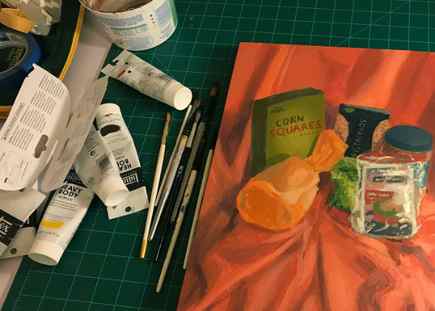However, before you run out and buy the first one you find, it’s worth bearing in mind the quick-dry nature of acrylic paint. This characteristic means that both plastic and wooden palettes won’t serve you as well as stay-wet palettes which have been developed specifically for working with acrylic paint.
Intro to Acrylic Painting
This video demonstrates important acrylic painting techniques in order to create a still life painting from beginning to end.

- Watch the 30 second short (shopping for palette knives)
- Watch the 3 min. version (still life set up)
- Watch the 3 min. version (glass palettes)
- Watch the 14 min. version (painting)
Responses

One of the many challenges I encountered while working on this piece was mixing the right colors I wanted, and properly shading areas of both shadow and different tone altogether. I found it was extremely easy to end up wasting a whole bunch of paint trying to mix a small swatch for just one small area of the painting, because you keep adding and adding paint and mixing it in and realize later that you have a giant lump on your palette that you won’t even use.
Additionally, I learned the hard way not to let brushes soak in my water container for too long (and completely dry them on a towel before diving into paint again), because when painting larger swaths of color, I began to realize that even a tiny bit of water turned my paint into a wash and killed the thick opacity of color I wanted.
Ruth Lee
I experimented with many compositions before choosing a final setup. The objects were placed on a silk cloth, which I moved around to create folds that would be interesting to paint. Next, I made a preliminary observational sketch with pencil on a wood canvas, and then began mixing colors. A challenge I faced during this time was knowing which colors were most important to the piece – I wanted to cover as much surface area in as little time as possible.
Then, I would be able to focus on details later as opposed to starting with detail work (which is a habit I have). After covering most of the canvas, I started to correct mistakes and work on details. At this point, I worked mostly from a photograph that I took of the piece because I got hungry and had to use some of the food for a meal!
Julie Sharpe

As a free educational source, Art Prof uses Amazon affiliate links (found in this page) to help pay the bills. This means, Art Prof earns from qualifying purchases.
Related

Abstract Acrylic Painting Prompts This video demos exciting painting prompts to get you started creating abstract paintings in acrylic,…
BBQ Squid: Mixed Media Acrylic Painting Teaching Artist Lauryn Welch demonstrates techniques for creating a mixed media acrylic painting that is…

Abstract Acrylic Painting Compositions with Collage See how to begin and develop an abstract painting composition with acrylic paints, starting with…
What is Acrylic Paint?

Before we dive into the pros and cons, the techniques and tools, and everything else you need to know about acrylic painting, let’s take a moment to see how the painting medium first came about.
Acrylic paint was essentially first conceived sometime during the early part of the 20th century by German chemist and entrepreneur Otto Röhm, when he first stumbled across acrylic resin. It wasn’t until the 1950s that it first became available to the general public though.
This resin has a wide variety of properties, such as fantastic water resistance, and it is incredible durability when solid, which makes it the perfect ingredient for paint.
Acrylic paint first came to artists’ attention due to its great versatility when compared with oil or watercolour paints, and as such it went on to become a staple of many a painter’s repertoire.
With acrylic paint one can achieve a variety of effects simply by adding water, or mixing up the mediums used with the paint. This made the process of painting and mixing up styles much more accessible and easier than was the case before the invention of acrylic paint, when painters had to go through the hassle of mixing their own paints.
For this reason and others, acrylic paint is often the preferred option for model enthusiasts. So if you’re looking to get into the world of model painting, you’ll probably need to become familiar with acrylic paint.
Types of Acrylic Paint
Acrylic paint can be purchased in two grades, professional and student. The professional grade paint, as the name suggests, is designed to be used by artists well-versed in the medium, and those who desire the most potential for creativity in terms of how they can manipulate the paint.
While the student grade acrylic paint is meant for anyone new to the paint, or those working on a budget since its more affordable than its professional counterpart.
Grade aside, there are also a wide variety of acrylic paints which can all achieve different styles and end products.
- Craft acrylics – The preferred paint for model painting. This is because craft acrylic paint is versatile and can be used on a variety of surfaces such as wood and ceramics.
- Interactive acrylics – Best for artists seeking to modify their work as they go along. Interactive acrylic paint grants the artist more scope to alter their painting by delaying the drying process when necessary.
- Open acrylics – Designed to extend the time it takes acrylic paint to dry, open acrylics are for those projects which require longer drying time, giving it a characteristic of oil painting.
- Iridescent acrylics – An extravagant option to give art an extra splash of colour, iridescent acrylics will create a glowing effect to really catch the eye.
- Exterior acrylics – The last noteworthy type of acrylic paint that may interest you, is exterior acrylics. Much like craft acrylics, these paints will serve you well on a variety of surfaces, plus they are highly water resistant making them ideal for outdoor use.
The best Painting tutors available

5 (22 reviews)
Mariana
1 st lesson free!

5 (14 reviews)
Diana
1 st lesson free!

5 (8 reviews)
Adam d
1 st lesson free!

5 (4 reviews)
Wiktoria
1 st lesson free!

5 (6 reviews)
Breon
1 st lesson free!

4.9 (9 reviews)
Tadeo
1 st lesson free!

5 (9 reviews)
Alex
1 st lesson free!

5 (11 reviews)
Sara
1 st lesson free!

5 (22 reviews)
Mariana
1 st lesson free!

5 (14 reviews)
Diana
1 st lesson free!

5 (8 reviews)
Adam d
1 st lesson free!

5 (4 reviews)
Wiktoria
1 st lesson free!

5 (6 reviews)
Breon
1 st lesson free!

4.9 (9 reviews)
Tadeo
1 st lesson free!

5 (9 reviews)
Alex
1 st lesson free!

5 (11 reviews)
Sara
1 st lesson free!
Let’s go
Acrylic vs Oil Painting
Acrylic painting, for those that don’t know, is the main alternative to oil painting. Acrylic paint tends to come in tubes, similar to oil paint, but unlike oil paint, it dries very quickly. As a result, it is a great paint to start out with, as you won’t need to wait a long time for it to dry.
Another reason why you might consider painting with acrylic over oil paints is how easy it can be cleaned up after use. The last thing you want as a beginner painter is to have to spend half the afternoon cleaning up after yourself, and literally waiting for paint to dry.
Painting with acrylics is also much more appealing in the sense that you can clean up after yourself using plain old tap water, rather than having to rely on foul-smelling chemicals to wipe off your brush as you would with oil paints.
Not to discredit oil painting too much, but acrylic painting can also be made to look like oil painting, or even watercolour, with a bit of practice. Since you can dilute it with water, you are able to achieve a variety of techniques and visuals, which make it highly versatile.
Of course, there are some drawbacks too, but these shouldn’t dissuade you from starting out with acrylic paint. The main downside is that there are fewer colours to choose from compared to oil paints, and the quick drying time might affect how you paint.
Introduction to Acrylic Paint Technique, Experimentation and Process

Gillian Ayres CBE RA, The Colour That Was There 1993. Tate. © Estate of Gillian Ayres RA CBE.
- Session breakdown
- Accessibility
- Related workshops
Join us for an introduction to Acrylic Paint at Tate Britain with Artist Educator and Art Therapist Alice Davies
This practical one-day workshop invites you to explore some traditional and more experimental acrylic paint techniques, looking at a brief history of this modern and versatile paint and how artists from the Tate Collection have used the material. Techniques learnt will then be applied to your own larger scale artworks.
Over the course of the session, you will build up the introductory skills and techniques needed to get you started making your own masterpieces.
The price of the workshop includes materials to take home with you, including a set of Winsor & Newton: Gillian Ayres Acrylics, produced in collaboration with Tate.
This session is for people aged 16 and over.
Session breakdown
Introduction, 15 minutes: A brief introduction to Tate and an introduction to the workshop and what it will entail, with a brief history of chalk pastels.
Part One, 50 minutes: In this part of the workshop, you will learn 8 different acrylic paint techniques following examples through hands-on exercises. Examples include blending, stippling, sponging, splattering, washing, dry brushing and detailing.
Tea Break, 15 minutes
Part two, 30 minutes: After learning the above techniques see artists within the Tate Collection and ways artists have used this material.
Part three, 50 minutes: Use learnt techniques and knowledge to make an inspired finished piece. Individual tips and any questions that you might have during the process will be answered.
Exhibition, 20 mins: View completed works, discuss the making process and how similar techniques were used differently by members of the group.
Accessibility
Tate Britain’s step-free entrance is on Atterbury Street. It has automatic sliding doors and there is a ramp down to the entrance with central handrails.
There is a lift between the Lower and Main floors. Alternatively you can take the stairs.
- Accessible and standard toilets are located on the Lower floor.
- A Changing Places toilet is not currently available.
- Ear defenders can be borrowed from the ticket desk on the Lower floor.
To help plan your visit to Tate Britain, have a look at our visual story. It includes photographs and information about what you can expect from a visit to the gallery.
For more information before your visit:
- Email [email protected]
- Call +44 (0)20 7887 8888 – option 1 (daily 09.45–18.00)





